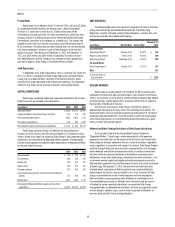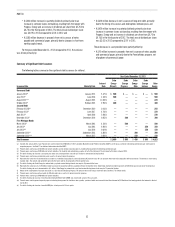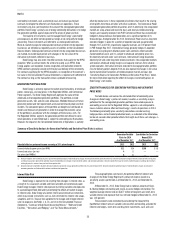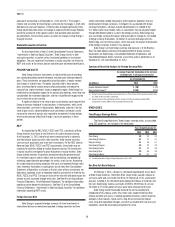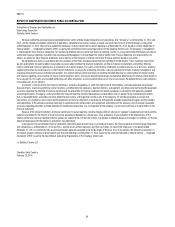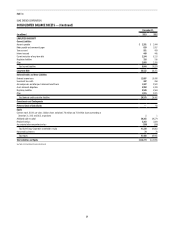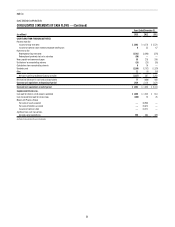Duke Energy 2013 Annual Report Download - page 75
Download and view the complete annual report
Please find page 75 of the 2013 Duke Energy annual report below. You can navigate through the pages in the report by either clicking on the pages listed below, or by using the keyword search tool below to find specific information within the annual report.
57
PART II
Global Climate Change
The Duke Energy Registrants’ greenhouse gas (GHG) emissions consist
primarily of CO2 with most coming from their fleet of coal-fired power plants in the
U.S. In 2013, the Duke Energy Registrants’ U.S. power plants emitted approximately
134 million tons of CO2. CO2 emissions from Duke Energy’s international operations
were approximately 3 million tons. The Duke Energy Registrants’ future CO2
emissions will be influenced by variables including new regulations, economic
conditions that affect electricity demand, and the Duke Energy Registrants’
decisions regarding generation technologies deployed to meet customer electricity
needs.
The Duke Energy Registrants do not anticipate any of the states in which
they currently operate fossil-fueled electric generating units to implement
requirements to reduce CO2 emissions absent a federal requirement to mandate
reductions in GHG emissions. On June 25, 2013, the President of the United
States issued a memorandum directing the EPA to propose CO2 emissions
requirements for existing fossil-fuel electric generating units by June 1, 2014,
and to finalize the guidelines for states to develop their own regulations for
implementing the guidelines by June 1, 2015. The memorandum directed the
EPA to require state to submit their implementation regulations for approval by
June 30, 2016.
The Duke Energy Registrants are taking actions that will result in reduced
GHG emissions over time. These actions will lower the Duke Energy Registrants’
exposure to any future mandatory GHG emission reduction requirements or
carbon tax, whether a result of federal legislation or EPA regulation. Under
any future scenario involving mandatory GHG limitations, the Duke Energy
Registrants would plan to seek recovery of compliance costs associated with
their regulated operations through appropriate regulatory mechanisms.
The Duke Energy Registrants recognize certain groups associate severe
weather events with climate change, and forecast the possibility these weather
events could have a material impact on future results of operations should
they occur more frequently and with greater severity. However, the uncertain
nature of potential changes of extreme weather events (such as increased
frequency, duration, and severity), the long period of time over which any
potential changes might take place, and the inability to predict these with any
degree of accuracy, make estimating any potential future financial risk to the
Duke Energy Registrants’ impossible. Currently, the Duke Energy Registrants
plan and prepare for extreme weather events they experience from time to time,
such as ice storms, tornados, hurricanes, severe thunderstorms, high winds
and droughts.
The Duke Energy Registrants routinely take steps to reduce the potential
impact of severe weather events on their electric distribution systems.
The Duke Energy Registrants’ electric generating facilities are designed to
withstand extreme weather events without significant damage. The Duke Energy
Registrants maintain an inventory of coal and oil on site to mitigate the effects
of any potential short-term disruption in fuel supply so they can continue to
provide customers with an uninterrupted supply of electricity. The Duke Energy
Registrants have a program in place to effectively manage the impact of future
droughts on their operations.
Other EPA Regulations Recently Published and Under Development
The EPA has issued and is in various stages of developing several
non-greenhouse gas (non-GHG) environmental regulations that will affect
the Duke Energy Registrants. These include the final Mercury and Air Toxics
Standards (MATS) for hazardous air pollutants, which is effective beginning in
2015, as well as proposed regulations for cooling water intake structures under
the Clean Water Act 316(b), coal combustion residuals, and steam effluent
limitation guidelines. As a group, these non-GHG environmental regulations
will require the Duke Energy Registrants to install additional environmental
controls and accelerate retirement of some coal-fired units. While the ultimate
regulatory requirements for the Duke Energy Registrants from the group of EPA
regulatory actions will not be known until all the rules have been finalized,
for planning purposes, the Duke Energy Registrants currently estimate the
cost of new control equipment that may need to be installed to comply with
this group of rules could total $4.5 billion to $5.5 billion, excluding AFUDC,
over the next 10 years. This range includes estimated costs for new control
equipment necessary to comply with the MATS of $525 million to $625 million.
The Duke Energy Registrants also expect to incur increased fuel, purchased
power, operation and maintenance, and other expenses in conjunction with
the non-GHG regulations. The Duke Energy Registrants are planning to retire
coal-fired generating capacity that is not economic to bring into compliance
with the EPA’s regulations. Beyond 2013, total planned and potential
retirements could exceed 2,400 MW of coal-fired generating capacity. The
Duke Energy Registrants also expect to incur costs for replacement generation
as a result of the potential coal-fired power plant retirements. Until the final
regulatory requirements of the group of EPA regulations are known and can
be fully evaluated, the potential compliance costs associated with these EPA
regulatory actions are subject to considerable uncertainty. Therefore, the actual
compliance costs incurred and MW to be retired may be materially different
from these estimates based on the timing and requirements of the final EPA
regulations.
For additional information, see Note 4 to the Consolidated Financial
Statements, “Regulatory Matters” and Note 5 to the Consolidated Financial
Statements, “Commitments and Contingencies.”
Nuclear Matters
Following the events at the Fukushima Daiichi nuclear power station
in Japan, Duke Energy conducted thorough inspections at each of its seven
nuclear sites during 2011. The initial inspections did not identify any significant
vulnerabilities, however, Duke Energy is reviewing designs to evaluate safety
margins to external events. Emergency-response capabilities, written procedures
and engineering specifications were reviewed to verify each site’s ability to
respond in the unlikely event of station blackout. Duke Energy is working within
the nuclear industry to improve safety standards and margin using the three
layers of safety approach used in the U.S.: protection, mitigation and emergency
response. Emergency equipment is currently being added at each station to
perform key safety functions in the event that backup power sources are lost
permanently. These improvements are in addition to the numerous layers of
safety measures and systems previously in place.
In March 2011, the NRC formed a task force to conduct a comprehensive
review of processes and regulations to determine whether the agency should
make additional improvements to the nuclear regulatory system. On July 13,
2011, the task force proposed a set of improvements designed to ensure
protection, enhance accident mitigation, strengthen emergency preparedness
and improve efficiency of NRC programs. The recommendations were further
prioritized into three tiers based on the safety enhancement level. On March 12,
2012, the NRC issued three regulatory orders requiring safety enhancements
related to mitigation strategies to respond to extreme natural events resulting in
the loss of power at a plant, ensuring reliable hardened containment vents and
enhancing spent fuel pool instrumentation.
On August 30, 2012, the NRC issued implementation guidance to enable
power plants to achieve compliance with the orders issued in March 2012.
Plants were required to submit implementation plans to the NRC by February
28, 2013, and complete implementation of the safety enhancements within two
refueling outages or by December 31, 2016, whichever comes first. Each plant
is also required to reassess their seismic and flooding hazards using present-
day methods and information, conduct inspections to ensure protection against
hazards in the current design basis, and re-evaluate emergency communications
systems and staffing levels.
Duke Energy is committed to compliance with all safety enhancements
ordered by the NRC in connection with the March 12, 2012, regulatory orders
noted above, the cost of which could be material. Until such time as the NRC-
mandated reassessment of flooding and seismic hazards is complete the exact
scope and cost of compliance modifications to Duke Energy’s sites will not be
known. With the NRC’s continuing review of the remaining recommendations,
Duke Energy cannot predict to what extent the NRC will impose additional




